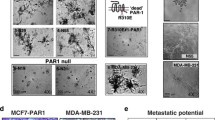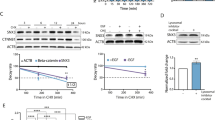Abstract
In breast cancer, it is the resulting metastasis that is the primary cause of fatality. pH regulatory proteins and the tumor microenvironment play an important role in metastasis of cancer cells and acid-extruding proteins are critical in this process. There are several types of breast cancer and triple-negative breast cancer tends to be more metastatic and invasive and is itself is composed of several types. MDA-MB-468 are a triple-negative breast cancer cell line and are classified as basal-like and basal tumors account for up to 15% of breast cancers. Here we examined the effect of removal of the acid-extruding protein, the Na+/H+ exchanger isoform one, from MDA-MB-468 cells. NHE1 was deleted from these cells using the CRISPR/Cas9 system. Western blotting and measurement of activity confirmed the absence of the protein. In wounding/cell migration experiments, deletion of NHE1 reduced the rate of cell migration in the presence of low- or high-serum concentrations. Anchorage-dependent colony formation was also greatly reduced by deletion of the NHE1 protein. Cell proliferation was not affected by knockout of NHE1. The results demonstrate that NHE1 has an important role in migration and invasion of basal-like triple-negative breast cancer cells.






Similar content being viewed by others
References
Jemal A, Siegel R, Ward E, Hao Y, Xu J, Thun MJ (2009) Cancer statistics. CA Cancer J Clin 59:225–249. https://doi.org/10.3322/caac.20006
Russo J, Han HJ, Kohwi Y, Kohwi-Shigematsu T (2008) New advances in breast cancer metastasis. Womens Health (Lond Engl) 4:547–549. https://doi.org/10.2217/17455057.4.6.547
Boyle P, d’Onofrio A, Maisonneuve P, Severi G, Robertson C, Tubiana M, Veronesi U (2003) Measuring progress against cancer in Europe: has the 15% decline targeted for 2000 come about? Ann Oncol 14:1312–1325
Weigelt B, Peterse JL, van ’t Veer LJ (2005) Breast cancer metastasis: markers and models. Nat Rev Cancer 5:591–602. https://doi.org/10.1038/nrc1670
Redig AJ, McAllister SS (2013) Breast cancer as a systemic disease: a view of metastasis. J Intern Med 274:113–126. https://doi.org/10.1111/joim.12084
Ahmad A, Hart IR (1997) Mechanisms of metastasis. Crit Rev Oncol Hematol 26:163–173
Sihto H, Lundin J, Lundin M, Lehtimaki T, Ristimaki A, Holli K, Sailas L, Kataja V, Turpeenniemi-Hujanen T, Isola J, Heikkila P, Joensuu H (2011) Breast cancer biological subtypes and protein expression predict for the preferential distant metastasis sites: a nationwide cohort study. Breast Cancer Res 13:R87. https://doi.org/10.1186/bcr2944
El Saghir NS, Tfayli A, Hatoum HA, Nachef Z, Dinh P, Awada A (2011) Treatment of metastatic breast cancer: state-of-the-art, subtypes and perspectives. Crit Rev Oncol Hematol 80:433–449. https://doi.org/10.1016/j.critrevonc.2011.01.010
Gerratana L, Fanotto V, Bonotto M, Bolzonello S, Minisini AM, Fasola G, Puglisi F (2015) Pattern of metastasis and outcome in patients with breast cancer. Clin Exp Metastas 32:125–133. https://doi.org/10.1007/s10585-015-9697-2
Holliday DL, Speirs V (2011) Choosing the right cell line for breast cancer research. Breast Cancer Res 13:215. https://doi.org/10.1186/bcr2889
Boyle P (2012) Triple-negative breast cancer: epidemiological considerations and recommendations. Ann Oncol 23(6):7–12. https://doi.org/10.1093/annonc/mds187
Lehmann BD, Bauer JA, Chen X, Sanders ME, Chakravarthy AB, Shyr Y, Pietenpol JA (2011) Identification of human triple-negative breast cancer subtypes and preclinical models for selection of targeted therapies. J Clin Invest 121:2750–2767. https://doi.org/10.1172/JCI45014
Bello E, Taraboletti G, Colella G, Zucchetti M, Forestieri D, Licandro SA, Berndt A, Richter P, D’Incalci M, Cavalletti E, Giavazzi R, Camboni G, Damia G (2013) The tyrosine kinase inhibitor E-3810 combined with paclitaxel inhibits the growth of advanced-stage triple-negative breast cancer xenografts. Mol Cancer Ther 12:131–140. https://doi.org/10.1158/1535-7163.MCT-12-0275-T
Lee Y, Kang E, Lee AS, Baek H, Kim EK, Park SY, Kim JH, Kim YJ, Kim SH, Kim IA, Eom KY, Kim SW (2015) Outcomes and recurrence patterns according to breast cancer subtypes in Korean women. Breast Cancer Res Treat 151:183–190. https://doi.org/10.1007/s10549-015-3390-7
Wu SG, Sun JY, Yang LC, Tang LY, Wang X, Chen XT, Liu GH, Lin HX, Lin Q, He ZY (2016) Patterns of distant metastasis in Chinese women according to breast cancer subtypes. Oncotarget 7:47975–47984. https://doi.org/10.18632/oncotarget.10099
Vaupel P (2004) Tumor microenvironmental physiology and its implications for radiation oncology. Semin Radiat Oncol 14:198–206. https://doi.org/10.1016/j.semradonc.2004.04.008
Andersen AP, Moreira JM, Pedersen SF (2014) Interactions of ion transporters and channels with cancer cell metabolism and the tumour microenvironment. Philos Trans R Soc Lond B Biol Sci 369:20130098. https://doi.org/10.1098/rstb.2013.0098
Parks SK, Chiche J, Pouyssegur J (2011) pH control mechanisms of tumor survival and growth. J Cell Physiol 226:299–308. https://doi.org/10.1002/jcp.22400
Webb BA, Chimenti M, Jacobson MP, Barber DL (2011) Dysregulated pH: a perfect storm for cancer progression. Nat Rev Cancer 11:671–677. https://doi.org/10.1038/nrc3110
Schwab A, Fabian A, Hanley PJ, Stock C (2012) Role of ion channels and transporters in cell migration. Physiol Rev 92:1865–1913. https://doi.org/10.1152/physrev.00018.2011
Yang X, Wang D, Dong W, Song Z, Dou K (2010) Inhibition of Na(+)/H(+) exchanger 1 by 5-(N-ethyl-N-isopropyl) amiloride reduces hypoxia-induced hepatocellular carcinoma invasion and motility. Cancer Lett 295:198–204. https://doi.org/10.1016/j.canlet.2010.03.001
Amith SR, Wilkinson JM, Fliegel L (2016) KR-33028, a potent inhibitor of the Na+/H+ exchanger NHE1, suppresses metastatic potential of triple-negative breast cancer cells. Biochem Pharmacol 118:31–39. https://doi.org/10.1016/j.bcp.2016.08.010
Lu X, Qin W, Li J, Tan N, Pan D, Zhang H, Xie L, Yao G, Shu H, Yao M, Wan D, Gu J, Yang S (2005) The growth and metastasis of human hepatocellular carcinoma xenografts are inhibited by small interfering RNA targeting to the subunit ATP6L of proton pump. Cancer Res 65:6843–6849. https://doi.org/10.1158/0008-5472.CAN-04-3822
Xie R, Wang H, Jin H, Wen G, Tuo B, Xu J (2017) NHE1 is upregulated in gastric cancer and regulates gastric cancer cell proliferation, migration and invasion. Oncol Rep 37:1451–1460. https://doi.org/10.3892/or.2017.5386
Stock C, Cardone RA, Busco G, Krahling H, Schwab A, Reshkin SJ (2008) Protons extruded by NHE1: digestive or glue? Eur J Cell Biol 87:591–599. https://doi.org/10.1016/j.ejcb.2008.01.007
Reshkin SJ, Greco MR, Cardone RA (2014) Role of pHi, and proton transporters in oncogene-driven neoplastic transformation. Philos Trans R Soc Lond B Biol Sci 369:20130100. https://doi.org/10.1098/rstb.2013.0100
Busco G, Cardone RA, Greco MR, Bellizzi A, Colella M, Antelmi E, Mancini MT, Dell’Aquila ME, Casavola V, Paradiso A, Reshkin SJ (2010) NHE1 promotes invadopodial ECM proteolysis through acidification of the peri-invadopodial space. FASEB J 24:3903–3915
Greco MR, Antelmi E, Busco G, Guerra L, Rubino R, Casavola V, Reshkin SJ, Cardone RA (2014) Protease activity at invadopodial focal digestive areas is dependent on NHE1-driven acidic pHe. Oncol Rep 31:940–946. https://doi.org/10.3892/or.2013.2923
Amith SR, Fliegel L (2017) Na(+)/H(+) exchanger-mediated hydrogen ion extrusion as a carcinogenic signal in triple-negative breast cancer etiopathogenesis and prospects for its inhibition in therapeutics. Semin Cancer Biol 43:35–41. https://doi.org/10.1016/j.semcancer.2017.01.004
Amith SR, Wilkinson JM, Baksh S, Fliegel L (2015) Na+/H+ exchanger (NHE1) as a novel co-adjuvant target in paclitaxel therapy of triple-negative breast cancer cells. Oncotarget 6:1262–1275
Amith SR, Wilkinson JM, Fliegel L (2016) Na+/H+ exchanger NHE1 regulation modulates metastatic potential and epithelial-mesenchymal transition of triple-negative breast cancer cells. Oncotarget 7:21091–21113. https://doi.org/10.18632/oncotarget.8520
Riaz M, van Jaarsveld MT, Hollestelle A, Prager-van der Smissen WJ, Heine AA, Boersma AW, Liu J, Helmijr J, Ozturk B, Smid M, Wiemer EA, Foekens JA, Martens JW (2013) miRNA expression profiling of 51 human breast cancer cell lines reveals subtype and driver mutation-specific miRNAs. Breast Cancer Res 15:R33. https://doi.org/10.1186/bcr3415
Kao J, Salari K, Bocanegra M, Choi YL, Girard L, Gandhi J, Kwei KA, Hernandez-Boussard T, Wang P, Gazdar AF, Minna JD, Pollack JR (2009) Molecular profiling of breast cancer cell lines defines relevant tumor models and provides a resource for cancer gene discovery. PLoS ONE 4:e6146. https://doi.org/10.1371/journal.pone.0006146
Badve S, Dabbs DJ, Schnitt SJ, Baehner FL, Decker T, Eusebi V, Fox SB, Ichihara S, Jacquemier J, Lakhani SR, Palacios J, Rakha EA, Richardson AL, Schmitt FC, Tan PH, Tse GM, Weigelt B, Ellis IO, Reis-Filho JS (2011) Basal-like and triple-negative breast cancers: a critical review with an emphasis on the implications for pathologists and oncologists. Mod Pathol 24:157–167. https://doi.org/10.1038/modpathol.2010.200
Ding J, Rainey JK, Xu C, Sykes BD, Fliegel L (2006) Structural and functional characterization of transmembrane segment VII of the Na+/H+ exchanger isoform 1. J Biol Chem 281:29817–29829
Li X, Dutta D, Jung M, Zimmermann R, Fliegel L (2020) Amino acids 563–566 of the Na(+)/H(+) exchanger isoform 1 C-terminal cytosolic tail prevent protein degradation and stabilize protein expression and activity. Int J Mol Sci. https://doi.org/10.3390/ijms21051737
Rivenbark AG, O’Connor SM, Coleman WB (2013) Molecular and cellular heterogeneity in breast cancer: challenges for personalized medicine. Am J Pathol 183:1113–1124. https://doi.org/10.1016/j.ajpath.2013.08.002
Comsa S, Cimpean AM, Raica M (2015) The story of MCF-7 breast cancer cell line: 40 years of experience in research. Anticancer Res 35:3147–3154
Paradiso A, Cardone RA, Bellizzi A, Bagorda A, Guerra L, Tommasino M, Casavola V, Reshkin SJ (2004) The Na+-H+ exchanger-1 induces cytoskeletal changes involving reciprocal RhoA and Rac1 signaling, resulting in motility and invasion in MDA-MB-435 cells. Breast Cancer Res 6:R616–R628
Amith SR, Fong S, Baksh S, Fliegel L (2015) Na (+)/H (+)exchange in the tumour microenvironment: does NHE1 drive breast cancer carcinogenesis? Int J Dev Biol 59:367–377. https://doi.org/10.1387/ijdb.140336lf
Amith SR, Fliegel L (2013) Regulation of the Na+/H+ exchanger (NHE1) in breast cancer metastasis. Cancer Res 73:1259–1264. https://doi.org/10.1158/0008-5472.CAN-12-4031
Cardone RA, Greco MR, Zeeberg K, Zaccagnino A, Saccomano M, Bellizzi A, Bruns P, Menga M, Pilarsky C, Schwab A, Alves F, Kalthoff H, Casavola V, Reshkin SJ (2015) A novel NHE1-centered signaling cassette drives epidermal growth factor receptor-dependent pancreatic tumor metastasis and is a target for combination therapy. Neoplasia 17:155–166. https://doi.org/10.1016/j.neo.2014.12.003
Toft NJ, Axelsen TV, Pedersen HL, Mele M, Burton M, Balling E, Johansen T, Thomassen M, Christiansen PM, Boedtkjer E (2021) Acid-base transporters and pH dynamics in human breast carcinomas predict proliferative activity, metastasis, and survival. Elife. https://doi.org/10.7554/eLife.68447
Acknowledgements
This research was funded by funding from the Cancer Research Institute of Northern Alberta to LF, Grant Number RES0050041 and by funding from the National Science and Engineering Research Council for Canada RGPIN-2020-03932 to L.F.
Author information
Authors and Affiliations
Contributions
XL produced the data, while L. Fliegel provided the concepts, organized and wrote the manuscript, and provided funding. All authors reviewed and approved the manuscript.
Corresponding author
Ethics declarations
Competing interest
The authors have no competing financial or non-financial interest.
Ethical approval
No patients were used in this study. No animals were used in this study. Ethical approval is not applicable.
Informed consent
Not applicable.
Data availability
Data will be made available upon reasonable request.
Additional information
Publisher's Note
Springer Nature remains neutral with regard to jurisdictional claims in published maps and institutional affiliations.
Rights and permissions
About this article
Cite this article
Li, X., Fliegel, L. Permissive role of Na+/H+ exchanger isoform 1 in migration and invasion of triple-negative basal-like breast cancer cells. Mol Cell Biochem 477, 1207–1216 (2022). https://doi.org/10.1007/s11010-022-04370-y
Received:
Accepted:
Published:
Issue Date:
DOI: https://doi.org/10.1007/s11010-022-04370-y




